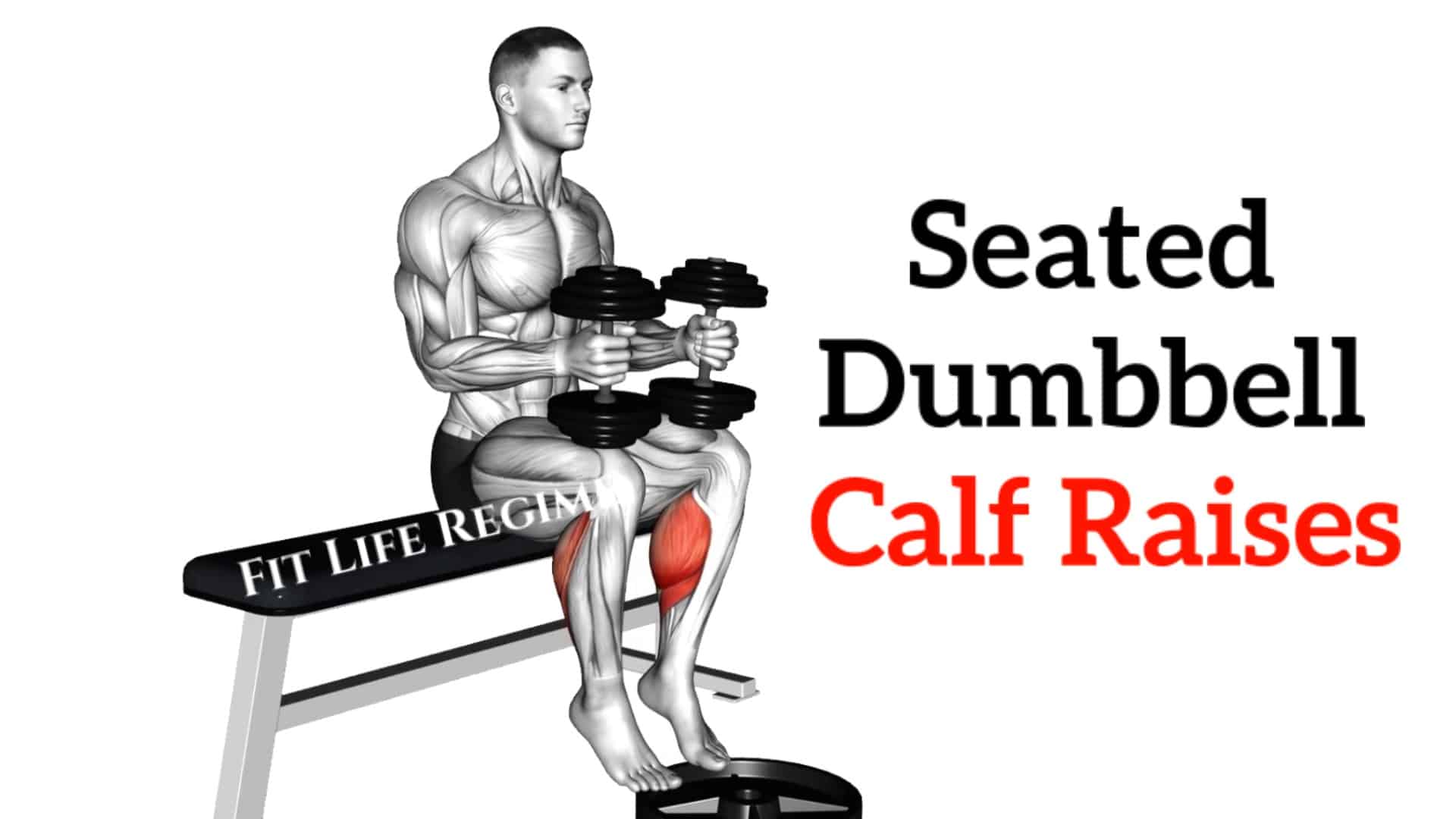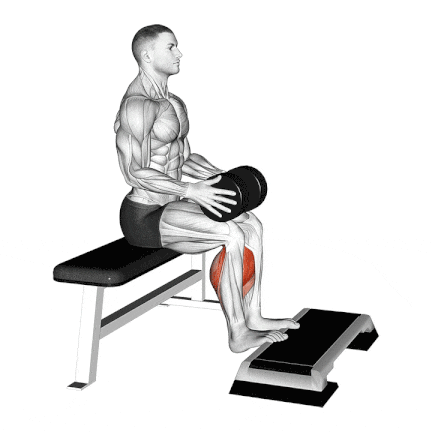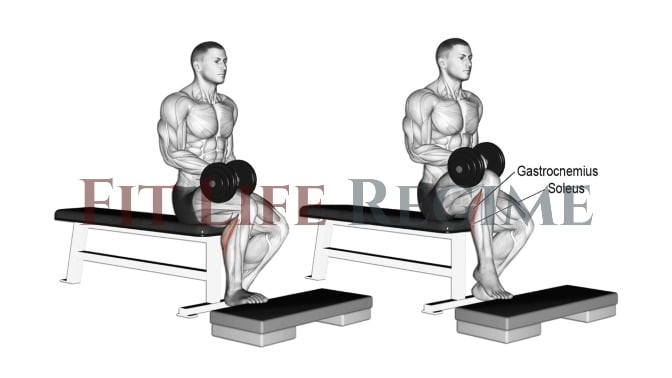The seated dumbbell calf raise is a good exercise for those who don’t have access to a seated calf raise machine. It is easy to do and only requires a set of dumbbells and a chair or bench.
You do this exercise by sitting on a chair or bench with a pair of dumbbells on your thigh and your feet on a raised surface like a step or block.
You then raise your heels and contract your calves. Then, you lower their heels back to the starting position.
You can do any of the variations of this exercise, depending on your preference and ability.

Seated Dumbbell Calf Raise Muscles Worked
The main muscles that are worked during seated dumbbell calf raises are the soles muscles.
Other muscle groups also worked.
- Gastrocnemius
- Plantaris
- Tibialis anterior and posterior
- Long toe extensor
Sitting raises mainly target the soleus, and standing calf raises focus on the gastrocnemius.
How To Do Seated Dumbbell Calf Raise
- Perch yourself on the edge of a flat bench (or a sturdy chair works, too). Keep your feet hip-width apart.
- If you’ve got a step or block handy, place the balls of your feet on the edge, letting your heels hang off. This increases the range of motion.
- Your knees should be bent 90 degrees, and your toes should be pointing straight ahead.
- Hold dumbbells on your thighs for resistance.
- Lower your heels as far as possible until you feel a stretch in your calves.
- Now, push through your heels, raising your calves up as high as possible. Feel the squeeze in your calves and hold for a second at the top.
- Do 10–12 reps and 3–4 sets. Remember, quality over quantity.

Tips and Form
- Use a high stepper plate and block. Don’t let your heels touch the floor at the bottom.
- Sit tall with your back straight and shoulders relaxed. Avoid slouching forward or leaning excessively.
- Don’t just use momentum to pump the weight. Move slowly and deliberately on both the raise and lower phases.
- For added resistance, you can hold a dumbbell in each hand.
- Exhale as you lift up, inhale as you lower down.
- Perform the exercise with bare feet or non-cushioned shoes for better activation.
- Don’t rush the reps. Do a controlled and deliberate movement.
- Traditionally, feet are hip-width apart with toes pointing forward. Try pointing your toes slightly outward to target the soleus muscle more (the deeper calf muscle).
- Want an extra challenge? Try performing seated calf raises with one leg at a time.
- If you’re a beginner, you can start by doing this exercise with a low weight for 3 sets of 10 to 12 reps.
- As you get stronger, you can increase your reps and use heavier dumbbells. 3 to 4 sets of 12 to 15 reps is an excellent goal for growing your calf muscles.
- It is usually recommended to do calf exercises 1-2 times a week.
Variations Of Seated Dumbbell Calf Raises
There are several variations of seated dumbbell calf raises that you can try to target different areas of the calf muscles. Here are a few examples:
- Single-leg seated dumbbell calf raises: This variation is performed with one leg at a time, allowing greater focus on each calf muscle.
- Seated dumbbell calf raises with toes pointed outward: This variation targets the outer calf muscles.
- Seated dumbbell calf raises with toes pointed inward: This variation targets the inner calf muscles.
Seated Dumbbell One Leg Calf Raise
By isolating each leg, you can ensure that both calves receive equal attention and work equally hard. This will help to correct any imbalances between your left and right calves.
If there are size and strength differences between your calves, perform this exercise first on your smaller or weaker calf, and do not perform more reps on your stronger calf.

How To Do Seated Dumbbell One-Leg Calf Raise
- Sit with the front of your right foot placed on top of a block or step in front of you.
- Hips and knees should be bent at a ninety-degree angle.
- Dip the heel of your right foot as low as it can go.
- Hold a dumbbell vertically on top of your right knee.
- Exhale as you lift your right heel as high as possible, pushing against the dumbbell’s weight.
- Keep your right heel lifted for 2 counts. Slowly lower it as you inhale.
- Repeat the exercise on your left foot.
In addition to seated dumbbell calf raises, there are several other calf exercises that you can add to your routine.
- Standing calf raises
- Jump rope
- Bodyweight calf raises
Benefits of Seated Dumbbell Calf Raises
Seated dumbbell calf raises offer a range of benefits:
- Targeted calf muscle development
- Increased calf strength
- Improved ankle stability
- Balanced lower body development
- Functional benefits for daily activities and sports
- Enhanced aesthetic appeal
- Potential for better joint and tendon health

Manish brings over 10 years of hands-on experience in weight lifting and fat loss to fitness coaching. He specializes in gym-based training and has a lot of knowledge about exercise, lifting technique, biomechanics, and more.
Through “Fit Life Regime,” he generously shares the insights he’s gained over a decade in the field. His goal is to equip others with the knowledge to start their own fitness journey.
